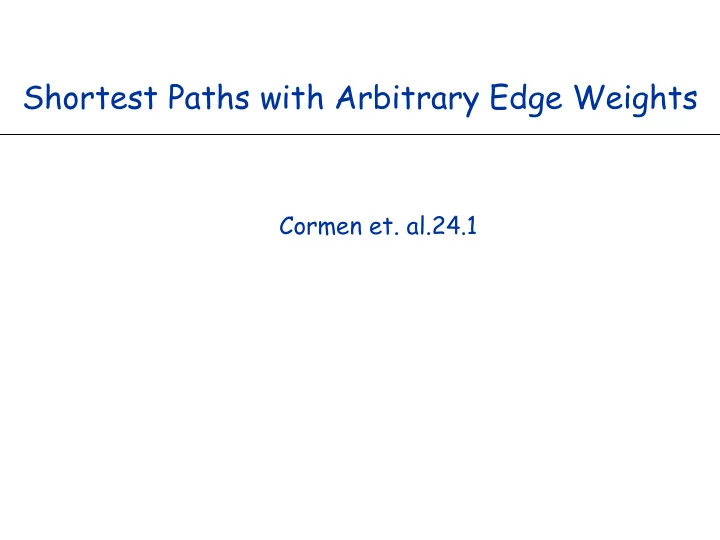

Shortest Paths with Arbitrary Edge Weights Cormen et. al.24.1
Shortest Path Problem Shortest path problem. Given a directed graph G = (V, E), with edge weights c vw , find shortest path from node s to node t. Th This is t tim ime w we a allo llow z zero ro a and n negative ive e edge w weig ights. 10 2 3 9 s 18 6 - 16 16 6 6 19 4 30 11 5 15 -8 6 16 20 t 7 44 2
Shortest Paths: Failed Attempts Dijkstra can fail with negative edge costs. Shortest path s to t is not s à t u 3 2 s v -5 1 t Re-weighting: what if we add large enough value to each edge weight so all weights>0? 2 2 s t 3 3 -3 3
Shortest Paths: Failed Attempts Dijkstra can fail with negative edge costs. Shortest path s to t is not s à t u 3 2 s v -5 1 t Re-weighting. Adding a constant to every edge weight can fail. Shortest path does not have the minimum number of edges. 6 6 2 2 s t 7 7 3 3 1 -3 4
Negative Cost Cycles Negative cost cycle. -6 -4 7 Observation. If some path from s to t contains a negative cost cycle, there does not exist a shortest s-t path; therefore we consider only graphs with no negative cycles s t W c(W) < 0 If there is no negative cycle the shortest path is simple (no nodes repeated). Wh What t about t 0 sum cyc ycles? 5
Bellman Ford SDSP Observation: as there are no negative cycles, and a zero sum cycle does not add to the path length, we can ignore cycles in our algorithm, searching for simple shortest paths, altogether. Therefore, a shortest path does not repeat any node. Therefore any shortest path has at most n-1 = |V|-1 edges. Objective: shortest path from node s to node t Define: OPT(i, v) = length of shortest v-t path using at most i edges.
A Dynamic Programming Approach OPT(i, v) = length of shortest v-t path using at most i edges. We want to create a recurrence, i.e. express OPT(i,v) in some Opt(j,w) j<i ■ Case 1: path uses at most i-1 edges. – OPT(i, v) = OPT(i-1, v) ■ Case 2: path uses up to i edges. – use edge (v,w), and then best w-t path using i-1 edges $ 0 if v = t , otherwise ∞ if i = 0 * * $ ' OPT ( i , v ) = % min { } min OPT ( i − 1, v ), OPT ( i − 1, w ) + c vw otherwise % ( * & ) * ( v , w ) ∈ E & What is the length of the optimal s-t path? OPT(n-1, s) , n = |V| 7
Bellman Ford -3 i 0 1 2 3 4 5 v a 6 t 0 -4 -1 4 d a ∞ t b b ∞ -2 2 e c ∞ 8 d ∞ c -3 3 e ∞ BF(G,s,t) n = |V| array M[0..n-1,V] foreach edge (v, w) Î E M[i,v] ¬ min(M[i-1,v], M[0,t]=0 M[0,v]= ∞ for all v!=t M[i-1,w]+c vw ) for i = 1 to n-1 compute M[i,v] using the recurrence return M[n-1,s]
Bellman Ford -3 i 0 1 2 3 4 5 v a 6 t 0 0 0 0 0 0 -4 -1 4 d a ∞ -3 -3 -4 -6 -6 t b b ∞ ∞ 0 -2 -2 -2 -2 2 e c ∞ 3 3 3 3 3 8 d ∞ 4 3 3 2 0 c -3 3 e ∞ 2 0 0 0 0 BF(G,s,t) O(mn mn) ) time, O(n (n 2 ) space. n=|V|, m=|E| E| n = |V| array M[0..n-1,V] foreach node v foreach edge (v, w) Î E M[0,t]=0 M[0,v]= ∞ for all v!=t M[i,v] ¬ min(M[i-1,v], for i = 1 to n-1 M[i-1,w]+c vw ) compute M[i,v] using the recurrence return M[n-1,s]
Practical Improvements Practical improvements. ■ Since we only refer to the previous column, we only need to maintain M[v] = length shortest v-t path that we have found so far. ■ Update is now: M[v] ¬ min { M[v], M[w] + c vw } ■ The role of i is only as a counter 10
Bellman-Ford: Efficient Implementation Shortest-Path(G, s, t) { foreach node v Î V { M[v] ¬ ¥ successor[v] ¬ None } M[t] = 0 for i = 1 to n-1 { foreach node w Î V { if (M[w] has been updated in previous iteration) { foreach node v such that (v, w) Î E { if (M[v] > M[w] + c vw ) { M[v] ¬ M[w] + c vw successor[v] ¬ w } } } If no M[w] value changed in iteration i, stop. } } 11
Detecting Negative Cycles Comment. Bellman-Ford can be used to detect negative cycles by running it one more iteration. Lemma. If OPT(n,v) = OPT(n-1,v) for all v, then there is no negative cycle on a path to t. because if there is a negative cycle, we can keep bringing OPT(i,v) down Lemma. If OPT(n,v) < OPT(n-1,v) for some node v, then there is a negative cycle on a path to t. because, as argued before, without negative cycles the path length (in edges) is at most n-1 12
Detecting Negative Cycles Theorem. Can detect negative cost cycle in O(mn) time. ■ Add new node t and connect all nodes to t with 0-cost edge. ■ Check if OPT(n, v) = OPT(n-1, v) for node t. – if so, then no negative cycles – if not, then extract cycle from shortest path from v to t t 0 0 0 0 0 18 2 6 -23 5 -11 v -15 13
Recommend
More recommend